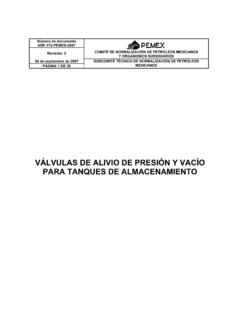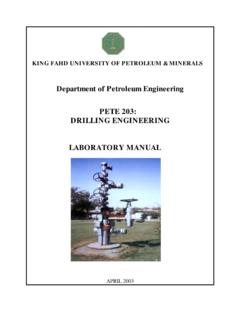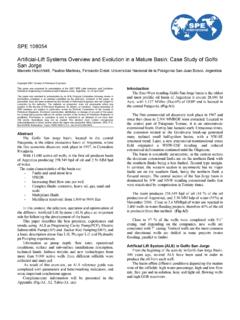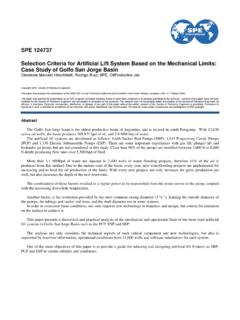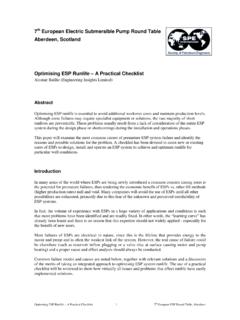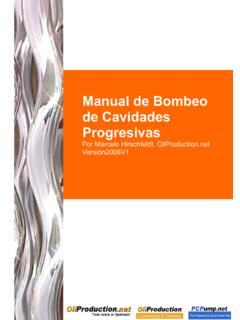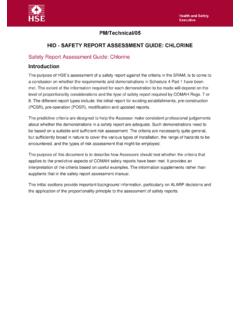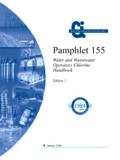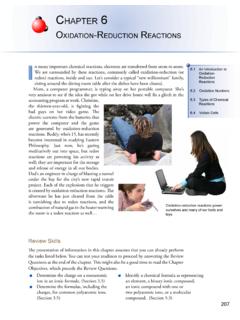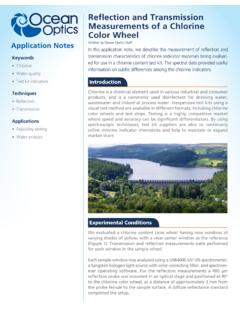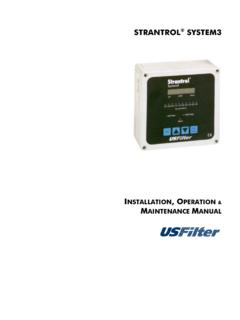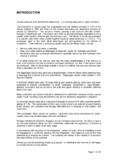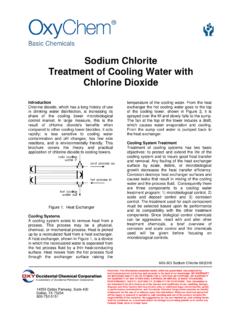Transcription of Introduction
1 Introduction Properties of Crude Oils and Oil Products 10/00 vii During any oil spill incident, the properties of the spilled oil must be known immediately. Unfortunately, the properties routinely measured by oil producers and refiners are not the ones that on-scene commanders need to know most urgently. Oil producers and refiners typically do not know to what extent or at what rate their oils will evaporate; the viscosity of the oil at ambient temperatures as it evaporates; if the oil is likely to sink or submerge; if dispersion can be enhanced with chemicals; if emulsions will form; the health hazard to on-site personnel from volatile organic compounds; or the toxicity to marine or aquatic organisms. The Emergencies Science Division (ESD), also known as the Environmental Emergencies Technology Division (EETD) prior to 1990, of Environment Canada, (the Canadian counterpart of the Environmental Protection Agency), is an organization that has been dedicated to performing oil and chemical spill research since 1973.
2 Since 1984, Environment Canada has been analyzing crude oils and oil products to determine not only basic physical properties, but also how oil behaves when spilled in the environment. A catalogue of oil properties, containing both data produced in-house and data from other sources was first prepared by Environment Canada in 1984. The oil catalogue has been so popular that interagency committees have requested that data collection and updating of the catalogue be an ongoing operation, and between 1986 and 1996, six updates were produced. This work has been continuously co-funded by the Minerals Management Service since 1989. The oil properties database now contains information on over 400 oils, and the database can also be accessed via the internet at For each oil in the database, the properties presented are those that determine its environmental behaviour and effects.
3 Environment Canada is the largest single source of data in the oil properties database. Whenever possible, Environment Canada has used standard test methods, such as those of the American Society for Testing and Materials (ASTM). In addition, many oil analytical methods have been developed by ESD specifically for determining environmentally significant oil properties and behaviours. These include methods for determining evaporation equations for oils, emulsion formation and characterization, measuring chemical dispersibility, measuring volatile organic compounds, and determining acute aquatic toxicity. Because evaporative loss results in significant changes in the physical properties and chemical composition of spilled oils, ESD measures most properties not only for fresh oils, but also for evaporated oils prepared in the laboratory to represent various degrees of evaporation.
4 Most of the oil analytical methods used by ESD are described in Appendix 1. Some ESD methods have been described in detail previously in the literature and the reader is referred to these sources to avoid unnecessary repetition. Data from many other sources are also included in the catalogue. The reader should be aware of the following points when searching for information on a specific oil. Crude oils from the same region are often given the same name even though oils from different wells can have markedly different properties. Oils that are transported are often blends of different crude oils, and the relative proportions of component oils frequently change. Therefore, the physical and chemical properties will vary. Similarly, the properties of oil taken from an individual well can vary with the depth of the well and the year of production. Also, different authors may refer to the same crude oil by different names, or to different crude oils by the same name.
5 Differences in reported values may be due to the variance of samples and inherent differences in measurement techniques. The reader who wishes to make use of such data should refer directly to the original source to obtain specific details on the techniques and parameters used. The crude oils and oil products are arranged in alphabetical order. Oil products are listed according to their most commonly used names. The names used to identify the oils in this catalogue are those used by the authors of the original data or by the suppliers of the samples. Common synonyms are included where appropriate. All names and synonyms are cross referenced in the Index. In addition, a list of oils by geographic origin has been included in Appendix 2. Description of Tests and Methods viii Properties of Crude Oils and Oil Products 10/00 API Gravity (See Density). Equations(s) for Predicting Evaporation Evaporation is a major process that contributes to the weathering of spilled oil.
6 While pure compounds evaporate at constant rates, oils, which are composed of thousands of compounds, do not. Rapid initial loss of the more volatile fractions is followed by progressively slower loss of less volatile components. It is not uncommon for 25% of the total volume of an oil spill to evaporate within one day of the spill (Fingas 79). Using a simple pan evaporation technique, evaporation rate equations have been developed for many different oils (Fingas 95a). For more details, see Appendix 1. Sulphur The sulphur content of a crude oil is important for a number of reasons. Downstream processes such as catalytic cracking and refining will be adversely affected by high sulphur contents. During an oil spill, the sulphur content becomes a health and safety concern for cleanup personnel. In addition, if high sulphur oils are burning, they can produce dangerous levels of sulphur dioxide.
7 The total sulphur content of oil can be determined by a number of standard techniques. ASTM method D 129 - Standard Test Method for Sulfur in Petroleum Products (General Bomb Method) is applicable to petroleum products of low volatility and containing at least mass percent sulphur (ASTM D 129). Sulphur contents from EETD and ESD were determined using a Horiba MESA 200 sulphur and chlorine analyzer, in accordance with ASTM method D 4294 - Standard Test Method for Sulfur in Petroleum Products by Energy-Dispersive X-Ray Fluorescence Spectroscopy. This method is applicable to both volatile and non-volatile petroleum products with sulphur concentrations ranging from to 5 mass percent (ASTM D 4294). Water Content Some of the oil samples received by ESD contain substantial amounts of water. Because any process that would separate the oil and water would also change the composition of the oil, most properties were determined on the oils as received.
8 Exceptions are noted in the individual data tables. Therefore, for those oils with significant water contents (>5%), many of the properties measured do not represent the properties of the dry oil. At ESD, water contents were determined by Karl Fischer titration using a Metrohm 701 KF Automatic Titrator. For more details, see Appendix 1. Flash Point The flash point of a fuel is the temperature to which the fuel must be heated to produce a vapour/air mixture above the liquid fuel that is ignitable when exposed to an open flame under specified test conditions. In North America, flash point is used as an index of fire hazard. As such, shipping regulations use flash point as a criterion to establish labelling requirements. Flash point is an extremely important factor in relation to the safety of spill cleanup operations. Gasolines and other light fuels can be ignited under most ambient conditions and therefore pose a serious hazard when spilled.
9 Many freshly spilled crude oils also have low flash points until the lighter components have evaporated or dispersed. There are several ASTM methods for measuring flash points, using either closed cup or open cup testers. Open cup methods will generally produce results that are higher than those measured with closed testers, and should not be used with volatile substances. The flash points of lubricating oils can be determined by ASTM method D 92/IP 36 - Standard Test Method for Flash and Fire Points by Cleveland Open Cup (ASTM D 92). For determining the flash points of other oils, methods D 93/IP 34 - Standard Test Methods for Flash Point by Pensky-Martens Closed Tester and D 56 - Standard Test Method for Flash Point by Tag Closed Tester are the most commonly used. The Pensky-Martens tester has an integral stirrer, but no cooling bath. The minimum flash Description of Tests and Methods Properties of Crude Oils and Oil Products 10/00 ix point that can be determined by method D93/IP34 is 10 C (ASTM D 93).
10 The Tag closed tester has an integral cooling bath, but no stirring mechanism. Method D 56 is intended for liquids with a viscosity less than cSt at 25 C (ASTM D 56). Many fresh crude oils have flash points below 10 C and/or viscosities above cSt at 25 C. For this reason, at ESD, a SUR BERLIN TAG 2 automatic flash point tester, which has been modified by adding a stirring mechanism, is used to determine flash points. The mechanism operates in a similar fashion to a Pensky-Martens tester, but is of a more efficient design. The stirrer aids in producing more uniform heat transfer to oils that exceed the design viscosity, and in no way interferes with the test mechanism. Flash points measured by this instrument are generally repeatable to 4 C. For more details, see Appendix 1. In the data section, flash points taken from the literature, and determined by open cup methods are designated by a footnote.
